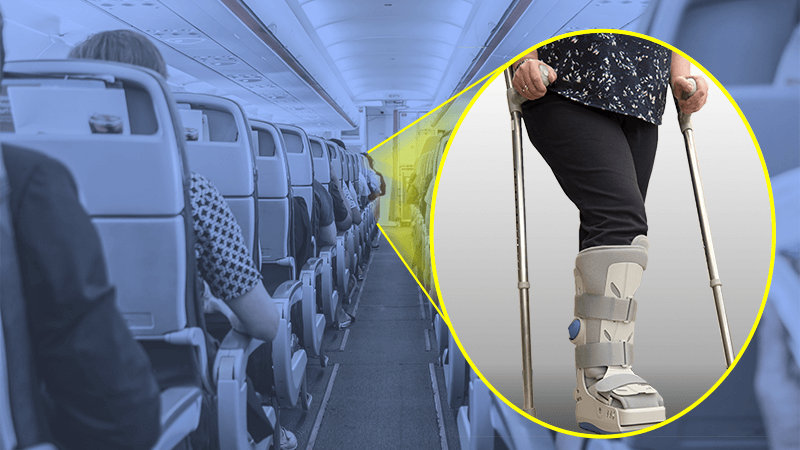 |
Issue 108
| Subscribers: 21,846 |
Oct 15, 2019
|
|
Practice Perfect 676
Can Patients Fly After Foot and Ankle Surgery? Part 1: What's the General Risk?
|
PRACTICE PERFECT October 15, 2019

|

|
Recently, I travelled to a conference via airplane, and while sitting in the airport lounge, I noted a person across from me wearing a CAM boot. It caused me to think back to a recent patient in my office who had sustained a fracture and decided not to fly to her vacation due to concerns of getting a deep venous thrombosis (DVT). I'd also had a similar patient who wanted to travel a few weeks after a surgery. I prescribed the patient enoxaparin as a prophylactic, which she accepted but didn't use when she was traveling.
|
This confluence of patient situations highlights how common this situation is. I also realized that I really didn't know the evidence, and therefore, didn't know whether there is significant risk for patients to do long plane flights after their foot and ankle injuries that required immobilization. The advice I've given over the years was based on wisdom that I received from my teachers and attendings and wasn't based on the evidence. As such, let's explore long air travel after foot and ankle surgery and immobilization. What is the actual risk of DVT when traveling by air? Should we allow our patients to travel by plane?
|
Get a steady stream of all the NEW PRESENT Podiatry e-Learning by becoming our Facebook Fan. Effective e-Learning and a Colleague Network awaits you.
|
|
The Basic Science
|
There is, of course, a logical scientific basis for the clot concern: Virchow's triangle. You'll recall this physiologic mechanism leading to increased coagulation risk is made up of blood vessel intimal injury, venous stasis, and hypercoagulability. Surgery of the lower extremity leads to all of these components, and one must wonder why we don't have more clotting episodes than we do? There are clearly balancing mechanisms to offset the clotting cascade, and it is for this reason that it's not a black and white "no, you can't fly after surgery" answer.
|
What's the DVT Travel Risk in General?
|
To gain some perspective on our question let's take a look at blood clot risks in general.
|
Arya and colleagues reviewed 568 passengers who went on long haul flights (defined as greater than three-hour trips in the preceding four weeks) who had suspected DVT1. They found an odds ratio (OR) of 1.3 when comparing DVT versus airline travel alone (no relationship of airline travel with DVT). However, when other factors were considered (surgery and previous DVT), the odds ratio increased to an average of 3.0.
|
Subscribe Now To see Conference Videos, Interviews, Sneak Peek Lecture Videos, and More!
|
|
Similarly, Cannegeiter et al performed a subgroup analysis of a larger study, the MEGA study, that examined risk factors for venous thrombotic events (VTE) in a large cohort2 . This was a case control cohort study that compared patients with a DVT episode with their spouses (the control group). Two hundred-thirty-three patients from the original study were identified to have travelled greater than four hours in the eight weeks preceding the DVT event. They found the risk of a VTE due to any kind of travel to have an odds ratio of 2.1 (a two-fold increased risk), and travel by plane, car, train, or bus had the same overall risk. Other factors significantly increased the risk: Factor V Leiden (OR 8.1), BMI kg/m2 > 30 (OR 9.1), height > 6'2" (OR 4.7), and use of oral contraceptives (OR > 20).
|
Ferrari, et al, by the same token, found an odds ratio of 3.98 for VTE in people who had undergone recent travel by train, airplane, or car when compared to a control cohort3. The trips were on average 5.4 hours. The authors stated that travel alone was a risk factor for VTE.
|

Cyclical Topical Oxygen Therapy for the Management of Chronic Wounds
|
|
Ron Guberman, DPM, DABPS
Director of Podiatric Medical Education
Co-Chief, Podiatry Division, Dept of Surgery
Wyckoff Heights Medical Center
Brooklyn, NY
|
 |
Ron Guberman, DPM, DABPS defines what topical wound oxygen multi-modality therapy is as well as reviews the role of oxygen in wound healing. Dr Guberman also investigates the benefits of topical oxygen therapy as well as reporting on current literature discussing the findings related to topical oxygen's affects on chronic diabetic foot ulcerations.
| Available Credits: CPME 0.5 |
PRESENT e-Learning Systems has designated an unrestricted educational grant from

to support this online education activity
|
|
|
These research studies and others looked at the relationship between travel and DVT in groups more likely to have DVT in the first place (a higher prevalence), so we are more likely to see DVT in these groups - something to keep in mind.
|
Based on these and other studies the following factors are believed to increase the risk of VTE after travel4:
|
- Prolonged travel times > 4-6 hours (2x risk)
- Age over 40 years
- Use of oral contraceptives (up to 20x risk)
- BMI > 30 kg/m2 (up to 9x risk)
- History of thrombophilia
- Tall or short stature (up to 5x risk)
- Recent surgery (up to 3x risk)
|
|
|
|
Prolonged travel times of 4-6 hours doubles the risk of DVT.
|
|
Join Now To get the Latest News, Press Releases, Announcements, Conference Information, and More!
|
|
We can make two primary conclusions:
|
- There is an increased risk of venous thromboembolic events during any prolonged type of travel (somewhere in the range of 2-4 fold increased risk).
- Patient-specific factors significantly increase the risk of a VTE above the baseline risk.
|
|
FOR comparison, while LONG trips double the risk of DVT, Oral Contraceptives raise the risk 20x, BMI>30kg/m2 raises it by 9x, recent surgery by 3x, and strangely enough, tall or short stature by 5x.
|
|
|
|

|
At this point, we can tell our patients with confidence that their clotting risk is elevated when they travel. What we haven't figured out yet is if recent foot and ankle surgery is one of those patient-specific factors that increase the risk of VTE while traveling. And that, my intrepid travel-concerned caregivers, is where I will leave you - a little cliffhanger to find out next week, when we'll discuss the clotting risks specifically associated with foot and ankle surgery and if there are suggestions we can make to patients to mitigate these possible risks. Until then...
|
|
Best wishes.

Jarrod Shapiro, DPM
PRESENT Practice Perfect Editor
jarrod@podiatry.com
|
 |
- Arya R, Barnes JA, Hossain U, Patel RK, Cohen AT. Long‐haul flights and deep vein thrombosis: a significant risk only when additional factors are also present. Br J Haematol. 2002 Mar;116(3):653-654.
Follow this link
- Cannegieter SC, Doggen CJ, van Houwelingen HC, Rosendaal FR. Travel-related venous thrombosis: results from a large population-based case control study (MEGA study). PLoS Med. 2006 Aug;3(8):e307.
Follow this link
- Ferrari E, Chevallier T, Chapelier A, Baudouy M. Travel as a risk factor for venous thromboembolic disease: a case-control study. Chest. 1999 Feb;115(2):440-444.
Follow this link
- Gavish I, Brenner B. Air travel and the risk of thromboembolism. Intern Emerg Med. 2011 Apr;6(2):113-116
Follow this link
|
This ezine was made possible through the support of our sponsors:
|
|
|
|
|
QUESTIONS? CONTACT US
info@podiatry 888-802-6888 podiatry.com © 2019 |
|
|
This email was sent to: rlb756@gmail.com
This email was sent by: PRESENT E-Learning Systems
5301 N. Federal Highway, Ste. 150 Boca Raton, FL 33487 USA
|
|
No comments:
Post a Comment
Thank you very much for leaving a comment. Due to my time restraints, some comments may not be answered.I will answer questions that I feel will help the community as a whole.. I can only answer medical questions in a general form. No specific answers can be given. Please consult a podiatrist, therapist, orthopedist, or sports medicine physician in your area for specific questions.